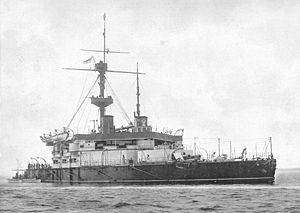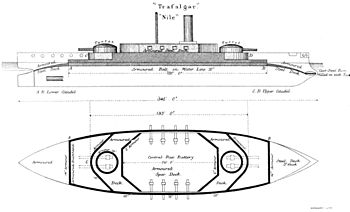Trafalgar-class ironclad

| |
| Class overview | |
|---|---|
| Operators | |
| Preceded by | Victoria class |
| Succeeded by | Royal Sovereign class |
| In commission | 1890–1911 |
| Completed | 2 |
| Retired | 2 |
| General characteristics [1] | |
| Type | Ironclad battleship |
| Displacement |
|
| Length | 345 ft (105 m) |
| Beam | 73 ft (22 m) |
| Draught | 27 ft 6 in (8.38 m) |
| Propulsion | 2 × coal-fired 3-cylinder steam engines, 6 cylindrical boilers, twin screws |
| Speed | 16.7 knots (30.9 km/h; 19.2 mph) |
| Complement | 577 |
| Armament |
|
| Armour |
|
The two Trafalgar-class battleships of the British Royal Navy were late-nineteenth-century ironclad warships. Both were named after naval battles won by the British during the Napoleonic Wars under the command of Admiral Nelson. The two ships were named HMS Nile and HMS Trafalgar.
Design
[edit]
Laid down in 1886, they were designed by William Henry White to be improved versions of the Admiral class,[citation needed] having a greater displacement to allow for improved protection. However they sacrificed a full armoured belt for greater thickness amidships in a partial belt.
They were originally intended to have a secondary armament of eight 5 inch guns but this was changed to six quick-firing 4.7 inch guns for use against attacking torpedo boats, which led to a weight increase of 60 tons, partly due to the increased amount of ammunition carried. This was one of the changes which led to the vessels being 600 tons overweight, causing an increase in draught of a foot.
The Trafalgars were the penultimate low-freeboard battleships built for the Royal Navy. This design had been favoured for several years because it reduced the size of the target that the ships presented to enemy guns in battle, and because the smaller hull area allowed thicker armour. However, as a consequence of having a freeboard of only about 15 feet, the vessels were unable to cope with very rough seas. This was mitigated by having them spend most of their active service in the relatively calm Mediterranean.
When they were built, many observers overestimated the vulnerability of large ships to torpedoes and the perceived inability to avoid them, which made them believe that large warships would inevitably be replaced by smaller, less vulnerable, and less valuable, vessels.[2] For example, John Hibbert, the parliamentary secretary of the Admiralty, told Parliament in March 1886: "I think I may safely say that these two large iron-clads will probably be the last iron-clads of this type that will ever be built in this or any other country. In France they are ceasing to go on with the construction of large iron-clads."[3]
Ships
[edit]| Name | Builder | Laid down | Launched | Completed |
|---|---|---|---|---|
| Trafalgar | Portsmouth Dockyard | 18 January 1886 | 20 September 1887 | 1890 |
| Nile | Pembroke Dockyard | 8 April 1886 | 27 March 1888 | 10 July 1891 |
Notes and references
[edit]- ^ Chesneau, Koleśnik & Campbell 1979, p. 31.
- ^ Hansard HC Deb 10 June 1886 vol 306 cc1322-425
George Shaw-Lefevre said in Parliament on 10 June 1886: "Admiral Sir Cooper Key, writing to The Times a few days ago in reference to these ships, said— 'I believe the time is approaching, indeed, is already arrived, when no more iron-clad ships will be laid down.' During the last two years other Naval Powers of Europe have, with one exception, ceased to build ships with their sides protected with armour; and even the noble and gallant Lord the Member for Marylebone (Lord Charles Beresford)... said, a few nights ago, that— 'He would not urge that the country should invest any more money in heavy iron-clads, because France had left off building any more—she had even left off building the two large iron-clads which had been begun [the Brennus and Charles Martel].' At the same time, there is a general consensus of opinion amongst naval men, and amongst men who are acquainted with the state of the Navy, that the chief want of the Navy at the present moment lies in fast vessels which are fit and proper for the protection of our commerce." - ^ Hansard HC Deb 18 March 1886 vol 303 cc1184-286
Bibliography
[edit]- D. K. Brown, Warrior to Dreadnought, Warship Development 1860–1906, ISBN 1-84067-529-2
- John Beeler, Birth of the Battleship, British capital ship design 1870–1881, ISBN 1-86176-167-8
- K. McBride, Nile and Trafalgar, The Last British Ironclads, in Warship 2000–2001, Conways Maritime Press
- Parkes, Oscar (1990) [1957]. British Battleships. Annapolis, Maryland: Naval Institute Press. ISBN 1-55750-075-4.
- Archibald, E.H.H.; Ray Woodward (ill.) (1971). The Metal Fighting Ship in the Royal Navy 1860–1970. New York: Arco Publishing Co.. ISBN 0-668-02509-3.
- Chesneau, Roger; Koleśnik, Eugène M.; Campbell, N.J.M. (1979). Conway's All the World's Fighting Ships 1860–1905. London: Conway Maritime Press. ISBN 0-85177-133-5.
